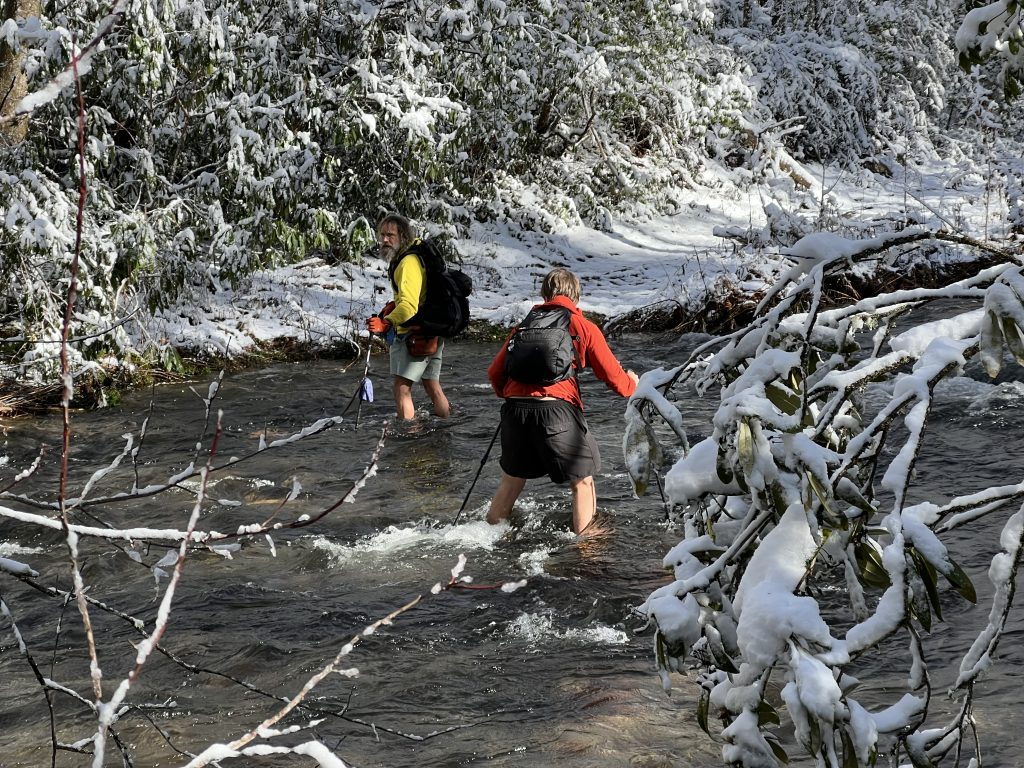I woke to a loud crack that sounded like a tree branch snapping. My tent collapsed on top of me – and I shot bolt up, startled out of the fog of early morning sleep.
It was 5am, January 3, at Camp 90 on the Lakeshore Trail in the Smoky Mountains National Park – during a not-so-ordinary Cary Academy Outdoors Club Leadership Trip. Several of our student campers woke to the same circumstances – as many of our lightweight tents collapsed under several inches of heavy snow.
Routes had changed several times in the weeks leading up to the trip, as the weather forecasts looked increasingly ominous. Mr. Rushin, the club’s faculty sponsor, sought to prepare us, sharing lengthy tips on how to prepare for cold and wet weather.
As the snow forecast solidified, a late call was made to alter our planned route. The team had expected to climb to elevation on the second day of the trip and walk along the iconic Application Trail, on the ridgeline separating the Tennessee and North Carolina borders. Worries about wind and snow at 5,000 feet scuttled those plans. Instead, we decided to do the lower part of the trip first, along Fontana Lake at around 1,800 feet. It was our hope that, after the snow passed, we’d have bright skies and warmer weather to welcome our uphill trek on the AT.
As we dug out on the morning of January 3, however, we were faced with stark realities. We were forced to reassess yet again. We had gotten more snow than expected; the sun remained stubbornly hidden behind the clouds. While it made for a very pretty morning hike, by our midday arrival at our next campsite, it seemed clear that the weather wasn’t cooperating. Worsening matters, we were now out of cell phone range and without means to get weather updates.
This being a trip for the Outdoors Club leaders, the group spent the next several hours discussing our options — as a whole group and in smaller sidebar conversations. We could adjust the itinerary again, staying lower for an additional day in hopes that the weather improved. Or, alternately, we could take a chance and make the climb the next morning, as planned, and then assess on the top of the ridge – coming down if it proved too cold. Without an obvious bailout campsite, should the additional snow slow our pace, the latter option could prove dangerous. Due to the wet and potentially windy conditions, fires were not guaranteed.
As a backpacking experience, this afforded some real-life opportunities to assess external factors such as weather and trail conditions. As a leadership experience, the group was able to gauge individual and group comfort with risk-taking as well as decision-making that extended beyond the wants of the individual to the needs of a larger group.
By the morning, the group had coalesced around an updated plan – there was too much risk to attempt the climb that day and try to camp on the ridge. We’d stay at the same camp a second night and day hike. Everybody was disappointed; we had come so far, and the AT was so close.
By the third morning, still more decisions loomed. We had one more night scheduled on the trail. Would we climb to spend the night on the ridge, or find a new camp somewhere mid-way? Or, instead, would we bail and just hike the 10 miles back to the vehicles and go home?
By this time, the group had gotten faster at assessing options. Everyone wanted to get to a ridgeline and the AT. By then we had abandoned our earlier itinerary, but there was a different climb we could take that would still get us to the AT, just at a lower point than previously planned. There was a campsite on the AT at that junction as well. There was still hope.
We made the call. While we would make the climb—which included seven wet, icy water crossings – we would not attempt to stay on the ridge. Instead, we would go up and down, sheltering back at the lower Fontana Lake.

The climb – which included a short 3-mile stretch where we gained nearly 3,000 ft — was spectacular. The snowfall meant that we had to find the trail during a good portion of the trip. Wet but warm from the exertion, we crested the ridge near Shuckstack at 4,000 ft. Immediately, we were met with 34-degree temps, stiff winds, and large snowdrifts covering the trail, immediate validation that our earlier concerns about weather-related risks were well-founded. While it was midday and sunny, the temperature had dropped some 20 degrees from the valley. Shivering, we bundled up as we took in incredible and rewarding views from the Shuckstack fire tower.
While some might be surprised to hear it characterized as such, overall, the trip was a tremendous success. I would argue that the challenges we faced made it a remarkable growth experience. We learned a great deal about real-world decision-making, with real-world risks. We learned that decision-making is often made in the vacuum of a complete data set and without clear green-light, red-light signals. Nobody got everything they wanted out of the trip, but collectively we managed to have a great (and safe) time — and felt the pride of a difficult challenge met together.
Upon arriving back to campus on Thursday, January 6, it was fascinating to hear our Leadership Team recall the process they went through as they assessed the school’s response to Omicron and the best way to restart in-person learning. The parallels between their decision process and our team’s on the mountain were not lost on me. As we finish our second week back in the New Year — I feel another sense of pride in a challenge met together.

